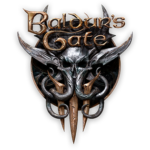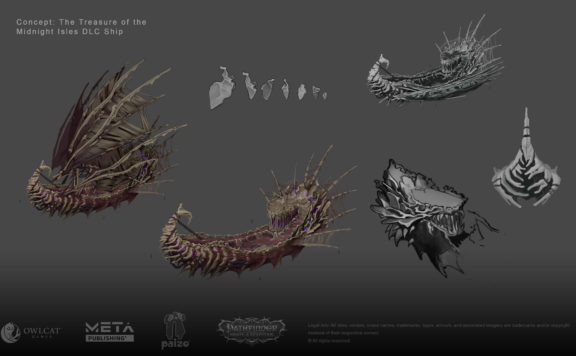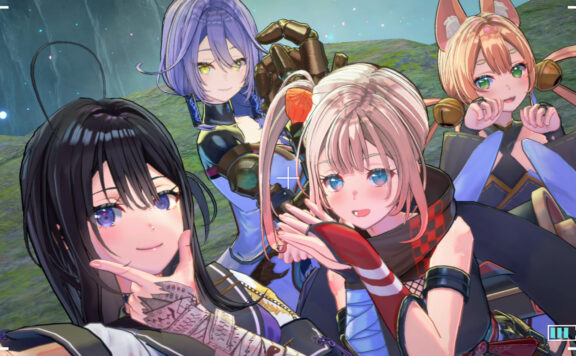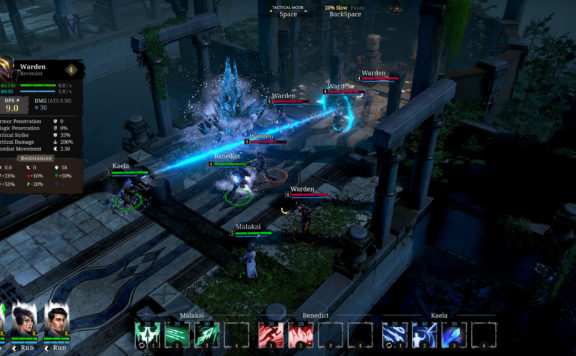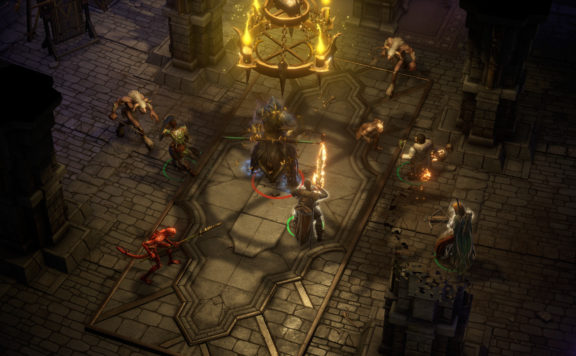Baldur’s Gate 3 is the game that made the world hold its collective breath with its release. Developer Larian Studios gathered its talent and the experience from years of creating deep, narrative-driven RPGs and revolutionized the genre all over again, delivering an unforgettable new adventure set in the Forgotten Realms.
BG3 remained in the Early Access stage for years, offering players a chance to explore a part of the first Act of the story and teasing with many enticing things to come. The available content was expanded to include the Underdark and Grymforge over time, introducing Druids, Bards, Barbarians and Paladins as playable classes. But one thought remained on everyone’s mind: what would it be like to return to Baldur’s Gate city after 20 years? What lies inside and beyond the Moonrise Towers?
The full version of the game offers an answer and so much more: more content for the first act, new companions, rewritten story for Wyll to name a few. Ready to gather your party and venture forth? This is our spoiler-free Baldur’s Gate 3 review.
The events of Baldur’s Gate 3 take place in the Forgotten Realms, the fantasy universe of magic, wonder, gods, monsters, unbreakable bonds and the will to overcome any obstacle. Needless to say, you will get to experience it all, sometimes against your wishes.
Much like the studio’s previous project Divinity: Original Sin 2 before it, Baldur’s Gate 3 gives you a choice between creating your own character from scratch or choosing one of the so-called Origin characters that serve as your companions. The experience of playing a custom ‘Tav’ and an Origin character like Gale is quite different, and Larian suggests trying the game out for yourself in your first playthrough before returning for seconds as another character.
The most unique Origin presented is that of the Dark Urge. Unlike the companion characters, it is a fully customizable one and has access to the game’s seriously spectacular character creator and all of its options: 11 races (with 31 subraces), 12 classes (46 subclasses) and hundreds of spells and actions to choose from.
Note that the Dark Urge playthrough deals with some pretty dark and sensitive topics. It is also incorrect to think that evil playthrough as a custom character equals the Dark Urge or that somehow Dark Urge is Tav+, making a custom character obsolete. The Dark Urge story is its own thing and it is a tale you will not experience unless you decide to play it yourself. Just take note that it is not for the faint of heart.
Regardless of the character you choose, there is one thing that brings your party together: no matter how different you are and what your goals might be, unless you stick together to take care of the Mind Flayer Tadpole, it is all going to end very badly, very soon. Or so the tale goes.
Having a group of vastly different characters from all walks of life pressed into working together leads to disagreements and many instances of opposing opinions and flaring tempers. Some characters insist on helping innocent bystanders, others argue that your time and opportunities are limited and need to be spent on yourselves only while a certain group just wants to watch the world burn. It is up to you to navigate the thin line that prevents your party from murdering each other or scattering into the wild – and it is a thrilling experience.
Of course, there is much more to the game’s story than just the Tadpoles. Each companion has their own personal quest chain that spans the entirety of the game and lets you know what drives that person. Frequently you can also influence your companions’ beliefs… and fates.

After dozens of hours of interacting with companions, there is only one drawback I could find. If your character is the one that started a conversation or encountered an item of some sort, it will be your character only passing the various related checks.
In some situations it makes sense – say, if you were the one to trigger a trap or if you get a Dexterity check in combat or even face an ambush, there is no time or opportunity for your companions to get involved on your behalf. But if you, a burly Barbarian, encounter a magic rune out in the wild while in the company of Gale and you are not pressed to do anything about it right now, you should be able to ask a more suitably gifted companion to help out.
Some conversations or interactions allow you to graciously bow out and swap characters to try again, but certain opportunities are wasted for good if you trigger them with the wrong person.
When it comes to gameplay, Baldur’s Gate 3 took almost everything Divinity: Original Sin 2 had to offer and cranked it up to 11. Thankfully, the Cursed/Blessed mechanic stayed back in Rivellon. Unlike the previous Baldur’s Gate games or the Pathfinder series, BG3 is exclusively turn-based. And the developers have improved and evolved the system in myriads of ways, adding reactions, counterspells and an option of beating goblins with another goblin as a barbarian with improvised weapons.
The game starts with your cast of characters, the protagonist and the companions alike, being infected by the Mind Flayer Tadpole. However, it is much more than just a story hook to get a highly diverse cast of characters together largely against their will. This status of being infected is a key to the events happening around Baldur’s Gate city and the very reason you will play one of the deciding roles in it. In addition to its narrative significance, it also plays a very important gameplay function.
Not only can you use the power of the parasite to delve into others’ thoughts, cheese some companion interactions and bluff your way through the cult of the Absolute, but it also serves as a separate ability tree if you decide to embrace the dark power it can provide. However, there will be a price to pay – you have to decide if you are willing to offer what it takes before you commit. In this regard, the approach to the Tadpole reminded me more of the Mythic Paths in Pathfinder: Wrath of the Righteous rather than the Source in D:OS2.
Players can reach the maximum of level 12 over the game’s three Acts. It is up to you if you want to progress fully as a single class or if you’d like to dabble into multi-classing. Either way, for a small fee you can respec your characters if you feel like you’ve made a mistake or just want to try something else.
The system starts off deceptively simple as you navigate the Nautiloid, but as you acquire more gear and unlock abilities, passives and feats, it adds layers upon layers of complexity. The possibility of interaction with the surroundings is astonishing, from simply shoving NPCs to their deaths to masterfully weaving barrelmancy into gameplay as you watch the world explode and burn around you. Hopefully, without friendly fire.

Another amazing aspect of gameplay and narrative alike is the sheer amount of options and choices you get to make. Not only do the race, sub-race and class of your character play a huge role – just try out being a Druid and/or Drow in the first act! – but you have a myriad of options when it comes to fulfilling tasks, interacting with characters and finishing quests.
If you kill an NPC and then cast Speak with the Dead, they are likely to refuse to talk to their murderer. But casting a shapeshifting spell allows you to bypass such an attitude. Additionally, your Druid can change into a much smaller form to sneak into tight, otherwise unavailable spaces – like a secret hideout of a bunch of children that will immediately flock and coo over your fluffy appearance. Speaking with animals also lets you in on many secrets and interesting tidbits of information that would be otherwise unavailable. You can even talk some aggressive wildlife out of attacking you and instead focus their fury on your enemies.
Similar kind of attention to details goes to quests, be it the main quest, companion tasks or just side quests you run into. Baldur’s Gate is also the kind of game that makes it interesting to fail – just to see how things will turn out if you can’t sweet talk or lie or even bruteforce your way out of a situation. I will admit to having save-scummed a couple of situations in the game where a failure meant an outcome I was not ready to face, but overall it is highly entertaining to see where the will of the die will lead you. After all, is it not the essence of D&D to adapt and overcome?
In addition to a stunning single-player campaign, BG3 also offers something even more incredible: an option to share this experience with friends in co-op. Of course, having another person with you leads to all sorts of shenanigans. It becomes easier to set up crazy elaborate schemes such as dragging explosive barrels to the field of battle to set it aflame spectacularly or distracting an NPC while Player 2 is up to some dastardly deeds.
However, BG3’s way of having the person that initiates the conversation be the one that does all the checks lends itself a bit awkwardly to multiplayer, relegating one player to always staying awhile and listening.
While BG3 was going through Early Access, I hoped the developers would sneak a look at Bioware’s story-driven MMORPG Star Wars: The Old Republic. In SWTOR, players could throw the dice to decide which choice will be made and which person will be leading the conversation from that point on, sometimes making the conversations feel like a back-and-forth between the members of the same party. SWTOR also features the “spectator mode” for private (mostly Class-based or late game main quest) conversations and for those moments when you don’t want to interrupt.
Baldur’s Gate 3 features three lengthy Acts, each of them easily the size of a fully-fledged RPG adventure on their own. The majority of Act I had been available in Early Access, but the full game saw certain changes: both the new content and the revamped quests and stories introduced to it. In essence, even those who had played the Early Access are sure to find a lot of new content even in the parts they explored. You can say that it serves as a 60-hour long prologue!
The game reaches its peak in Act II, when you get the taste of the scale of the conspiracy you got drawn into and experience Baldur’s Gate city and its daily life. Having escaped the immediate peril in Act I, you also get closer to your companions and experience more of their stories, perhaps changing the paths of their lives in the process. Your party is certainly not out of hot water yet.
However, when it comes to Act III, it seems like the game has gotten too big and ambitious for its own good. At a certain point, it feels like the developers have decided “That’s it, we have to wrap this up before it gets out of control” – and BG3 reflects this mindset by abruptly pushing you towards the endgame and leaving certain stories unexplored or almost abandoned, companion fates included. Similarly, the performance and optimization of Act III suffers compared to the earlier parts of the game. I’d venture to say that the amount of lag, crashes and framerate drops of the late game is more than the early game combined.
The studio’s previous work, Divinity: Original Sin 2, suffered from a similar thing until the Definitive Edition revamped the last third of the game. Hopefully, Larian glances back at DOS2 and takes another page from its book, enhancing the pacing and the narrative continuity of BG3 in the process.
With few exceptions, the cRPG genre has always been a relatively niche one. However, recent entries including Baldur’s Gate 3 have revitalized the genre and proven that a great single-player game can gather a huge passionate playerbase, no microtransactions or live service elements needed. If you enjoy narrative-driven RPGs that feature deep roleplaying systems and a cast of great characters, you owe it to yourself to give Baldur’s Gate 3 a chance. I have not felt such a rush of emotions since Dragon Age: Origins.
Note: the Steam version of the game is a verified purchase by the author.
Similar to:
- Divinity: Original Sin 2
- Dragon Age: Origins

